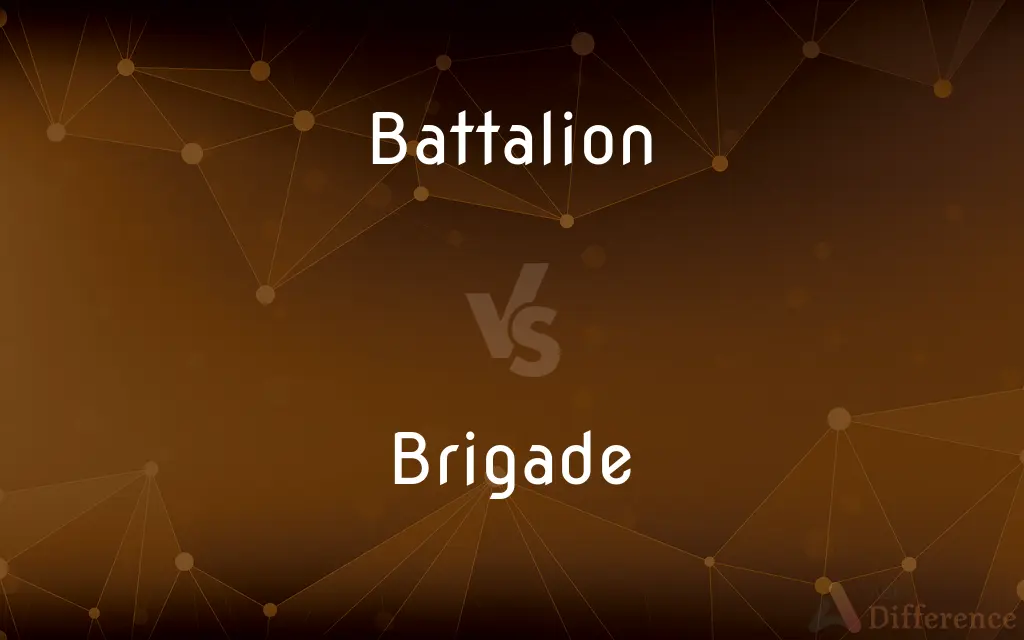Battalion vs. Brigade — What's the Difference?
Edited by Tayyaba Rehman — By Maham Liaqat — Updated on March 26, 2024
A battalion typically consists of 300-800 soldiers and serves as a subunit of a brigade, which contains multiple battalions and can number over 1,000 personnel, highlighting differences in size and command structure.

Difference Between Battalion and Brigade
Table of Contents
ADVERTISEMENT
Key Differences
A battalion is a military unit usually consisting of 300 to 800 soldiers. It is commanded by a lieutenant colonel and is part of a larger unit called a brigade or regiment, depending on the country's military structure. On the other hand, a brigade is larger, often comprising several battalions, with anywhere from 1,000 to 5,000 soldiers. It's led by a brigadier or a colonel, depending on the military's hierarchical norms.
Battalions operate as the basic maneuver units in the army, capable of independent operations but usually functioning under the command of a brigade for coordinated efforts. Whereas brigades serve as the main building blocks of divisional forces, providing a higher level of operational flexibility and strategic mobility across varied terrains and in different combat scenarios.
The organizational structure of a battalion allows for specialization, with units typically organized by function (infantry, artillery, engineering, etc.). In contrast, a brigade combines these specialized battalions to achieve operational objectives, showcasing a broader spectrum of capabilities.
In terms of command, a battalion's leadership is more directly involved in the tactical aspects of its unit's operations, focusing on immediate combat tasks and soldier welfare. A brigade's command structure, on the other hand, deals with strategic planning and coordination among its constituent battalions, requiring a broader view of the battlefield and operational goals.
The deployment of battalions is often dictated by the need for specific tactical maneuvers or to hold particular areas within a conflict zone. Brigades, however, are deployed with strategic objectives in mind, such as securing larger geographical areas or conducting operations that require combined arms capabilities.
ADVERTISEMENT
Comparison Chart
Size
300-800 soldiers
1,000-5,000 soldiers
Command
Lieutenant Colonel
Brigadier or Colonel
Function
Basic maneuver and operational unit
Strategic planning and coordination unit
Organizational Use
Specialized by function (infantry, artillery)
Combines specialized units for broader tasks
Deployment
Tactical maneuvers, specific areas in conflict
Strategic objectives, larger geographical areas
Compare with Definitions
Battalion
Commanded by a lieutenant colonel.
The battalion commander briefed the troops on the upcoming operation.
Brigade
A large military unit made up of several battalions.
The brigade was stationed along the border for defense.
Battalion
Operates under brigade or regiment.
The battalion was part of the 3rd Brigade.
Brigade
Suited for broad strategic missions and multi-battalion operations.
The brigade launched a coordinated attack at dawn.
Battalion
Used for smaller, tactical operations within a larger conflict.
A battalion was deployed to secure the village outskirts.
Brigade
Led by a brigadier or colonel.
The brigade commander outlined the campaign strategy.
Battalion
Organizes soldiers based on specific functions.
The engineering battalion was tasked with bridge construction.
Brigade
Combines various functional battalions for versatility.
The brigade included infantry, artillery, and support battalions.
Battalion
A military unit composed of several companies or similar units.
The battalion moved through the forest silently.
Brigade
Focuses on operational flexibility and strategic mobility.
The brigade's mobility allowed for rapid redeployment.
Battalion
A battalion is a military unit, typically consisting of 300 to 1000 soldiers commanded by a lieutenant colonel, and subdivided into a number of companies. In some countries, battalions are exclusively infantry, while in others battalions are unit-level organizations.
Brigade
A brigade is a major tactical military formation that is typically composed of three to six battalions plus supporting elements. It is roughly equivalent to an enlarged or reinforced regiment.
Battalion
A military unit typically consisting of a headquarters and two or more companies, batteries, or similar subunits.
Brigade
A military unit consisting of a variable number of combat battalions or regiments.
Battalion
A large body of organized troops.
Brigade
A US Army administrative and tactical unit composed of a headquarters unit, at least one unit of infantry or armor or both, and designated support units. A brigade can be commanded by a brigadier general or by a colonel.
Battalion
A great number
Battalions of ants.
Brigade
A group of persons organized for a specific purpose
Formed a bucket brigade to carry water to the fire.
Battalion
(military) An army unit having two or more companies, etc. and a headquarters. Traditionally forming part of a regiment.
Brigade
To form into a brigade.
Battalion
An army unit having two or more companies, etc. and a headquarters; forming part of a brigade.
Brigade
A group of people organized for a common purpose.
A work brigade; a fire brigade
Battalion
Any large body of troops.
Brigade
(military) Military unit composed of several regiments (or battalions) and including soldiers from different arms of service.
Battalion
(by extension) A great number of things.
Brigade
(derogatory) A group of people who share views or a specific characteristic.
More sympathy for career criminals from the bleeding-heart brigade!
I wouldn't even want to be seen dead with those nerds of the bowl-cut brigade.
Battalion
To form into battalions.
Brigade
(Internet slang) Coordinated online harassment, disruption or influencing, especially organized by an antagonistic website or community.
Battalion
A body of troops; esp. a body of troops or an army in battle array.
Brigade
To form or unite into a brigade; to group together.
Battalion
An infantry command of two or more companies, which is the tactical unit of the infantry, or the smallest command which is self-supporting upon the battlefield, and also the unit in which the strength of the infantry of an army is expressed.
Brigade
(Internet slang) To harass an individual or community online in a coordinated manner.
Battalion
To form into battalions.
Brigade
A body of troops, whether cavalry, artillery, infantry, or mixed, consisting of two or more regiments, under the command of a brigadier general.
Battalion
An army unit usually consisting of a headquarters and three or more companies
Brigade
Any body of persons organized for acting or marching together under authority; as, a fire brigade.
Battalion
A large indefinite number;
A battalion of ants
A multitude of TV antennas
A plurality of religions
Brigade
To form into a brigade, or into brigades.
Brigade
Army unit smaller than a division
Brigade
Form or unite into a brigade
Common Curiosities
What is the primary difference between a battalion and a brigade?
The primary difference lies in size and command, with battalions being smaller units led by lieutenant colonels and brigades larger units commanded by brigadiers or colonels.
What types of operations are battalions used for?
Battalions are used for tactical operations, including specific combat tasks, area control, and specialized functions like infantry assaults or engineering projects.
Can a brigade operate independently?
Yes, brigades are designed to operate independently, with a broad set of capabilities for strategic missions.
What is the role of a brigade commander?
A brigade commander is responsible for strategic planning, coordinating the actions of their constituent battalions, and overseeing broader operational goals.
Are brigades always larger than battalions?
Yes, by definition, brigades are larger, comprising several battalions to form a more substantial force.
How is a battalion structured?
A battalion is typically structured around a core function, such as infantry or artillery, and is made up of several smaller units like companies.
Do all countries use the same battalion and brigade structures?
While the concepts of battalions and brigades are widespread, their exact structures and sizes can vary significantly between different countries' armed forces.
Can battalions undertake independent operations?
Yes, battalions are capable of conducting independent operations, though they often operate within the larger framework of a brigade or division.
What determines the deployment of a battalion vs. a brigade?
Tactical needs and the scale of the operation usually determine whether a battalion or brigade is deployed, with battalions focusing on specific tasks and brigades on broader strategic objectives.
How does the command focus differ between a battalion and brigade?
Battalion commanders focus on tactical aspects and direct combat operations, whereas brigade commanders oversee strategic planning and coordination.
How many battalions are in a brigade?
This can vary, but a brigade typically consists of 2 to 5 battalions.
What makes a brigade versatile?
A brigade's versatility comes from its combination of different types of battalions, allowing it to undertake a wide range of military operations.
What is the relationship between a battalion and its higher command?
A battalion typically operates under the command of a brigade or regiment, contributing to larger strategic objectives and benefiting from coordinated command and control.
What is the significance of battalion specialization?
Battalion specialization allows for the efficient execution of specific military functions, such as combat, support, or logistics, contributing to the overall effectiveness of military operations.
How do brigades contribute to operational flexibility?
Brigades, with their combined arms capabilities and diverse battalion compositions, offer significant operational flexibility, allowing them to adapt to various combat scenarios and missions.
Share Your Discovery

Previous Comparison
Marina vs. Harbor
Next Comparison
Methodical vs. LogicalAuthor Spotlight
Written by
Maham LiaqatEdited by
Tayyaba RehmanTayyaba Rehman is a distinguished writer, currently serving as a primary contributor to askdifference.com. As a researcher in semantics and etymology, Tayyaba's passion for the complexity of languages and their distinctions has found a perfect home on the platform. Tayyaba delves into the intricacies of language, distinguishing between commonly confused words and phrases, thereby providing clarity for readers worldwide.
















































